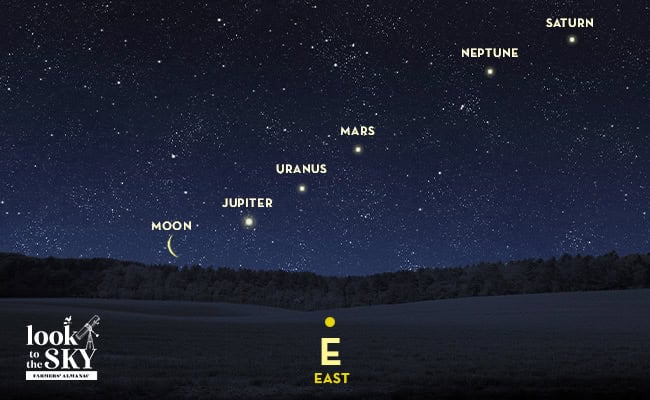Parade Of Planets 2024

Are you ready for the Parade of Planets 2024!? Early-risers, keep your eyes peeled for Jupiter, Uranus, Mars, Neptune, Saturn, and even the dwarf planet Pluto which will be in the sky at the same time before sunrise from June 24-July 4, 2024. Also, you’ll be able to watch the Moon pass by each planet one by one during this time frame. What will you actually see? When and where exactly should you look? What equipment will you need? Here is your Parade of Planets 2024 go-to guide.
Look Before Sunrise
The important thing to note is that the Parade of Planets 2024 only occurs before sunrise and will not be visible in the evening. In fact, nighttime skywatchers have been in a planet drought—when no planets have been visible in the sky just after dark. But the planet drought will end with Mercury making a brief appearance in early July and Venus slowly but surely emerging from behind the Sun and popping out to the evening sky later this summer.
The first planet to rise above the eastern horizon is Saturn which will clear the treetops about 1 a.m. local time. Neptune will quickly follow, rising about 30 minutes later. The planet Mars will rise about 3:30 a.m., just north of east. It will be equal in brightness to Saturn but shine with a distinctly orange color. Uranus rises one half hour later at 4 a.m. and then brilliant Jupiter comes up a little before 5 a.m. The planets will appear in this order from left to right: Jupiter, Uranus, Mars, Neptune, and Saturn. (See a reference illustration in the feature image for this story.)
The Sun will quickly follow the planets. As dawn approaches, and the sky brightens, the planets will become invisible.
Have you ever seen a Parade of Planets? Share in the comments!
Parade Of Planets 2024: Key Dates
To help you keep track of the planets, the Moon will pass through the parade between June 24 and July 4. As the Moon circles the Earth, its position shifts slightly each morning. The Moon, like the planets, also appears to travel near the ecliptic and will pass by each object on our list and can help you locate the tougher-to-find worlds.
June 24
After midnight on June 24, Pluto rises before any of the planets. You will not see Pluto with the naked eye, but you will see a waning gibbous Moon shining brilliantly in the southeastern sky. On the morning, the Moon serves as a landmark for knowing approximately where Pluto is.
If you have a really good telescope, you may attempt to find Pluto about 2 degrees above the Moon. But do not worry if you cannot find the dwarf planet Pluto—few trained astronomers can.
June 27
The significant Moon-planet pairings begin on the morning of June 27 when the waning Moon will shine three degrees to the right of the planet Saturn.
If you have even a simple backyard telescope, aim it at the Moon to observe the rough cratered lunar surface in more detail. Then shift the telescope over to Saturn. To the naked eye, Saturn looks like an ordinary yellow star. But through a telescope you can see the rings around the planet.
Related products: Starry Night Gift Guide
June 28
On June 28 about an hour before sunrise, the Moon will have shifted remarkably close to the planet Neptune. In fact, for portions of that morning, the Moon will appear less than one half degree below Neptune.
Get out that telescope and aim it at the Moon that morning. Then move your view ever so slightly up and look for a deep blue dot of light. This may be your best chance this year to find Neptune since the Moon can be your guide.
July 1
The Moon will pass the final three planets in the parade quickly. Before sunrise on July 1, the Moon will appear up and to the right of Mars.
July 2
On July 2, the Moon will be to the left of Uranus. Although you cannot see Uranus with the naked eye, you may be able to see another astronomical sight to the left of the Moon: The Pleiades star cluster also known as the Seven Sisters may just barely shine through the approaching dawn near the Moon.
July 3
Finally, before sunrise on July 3, the waning crescent Moon will shine to the left of Jupiter. You will have to time this well since Jupiter and the Moon will be low in the eastern sky and the Sun will be rising. Look for the Moon-planet pairing about 30-45 minutes before sunrise on July 3.
July 4
There is still a chance to catch the Parade of Planets 2024 on the morning of July 4, but the Moon will be very low on the horizon and therefore extremely tough to catch.
Psst … have you seen your Fourth of July Weather Forecast? Tap here!
Visibility Details
Although it does sound impressive to have five planets and Pluto lined up in the sky, visibility may disappoint you. The planets Uranus and Neptune cannot be seen with the naked eye. And to even spot Pluto as a tiny pale dot, you would need a sufficiently large or professional telescope. So that really leaves just three planets that you will actually observe in an arc across the east and southeastern pre-dawn sky: Jupiter low in the east, Mars up and to the right of Jupiter, and Saturn far off to the right of Mars. That said, knowing all of these planets are together in the morning sky between St. John’s Day and the Fourth of July is symbolically special.
Related
Planet Distances
The planets vary in size and distance from Earth. When we see planets in the sky, we are seeing sunlight reflecting off their surfaces (and some planets are more reflective than others). This all leads to a variety of planet brightness.
Jupiter
Although it is about 540 million miles away, the planet is so large and reflects so much sunlight that it is easily the brightest of the five planets up in the morning sky this summer.
Mars and Saturn
Mars and Saturn are nearly equally bright and easily detected with the naked eye. Mars is a much smaller planet than Saturn but also significantly closer to Earth. Mars is about 160 million miles away while Saturn is about 860 million miles away.
Uranus and Neptune
Although Uranus and Neptune are large planets (each is about four times the diameter of Earth), they are so far away that you need a telescope just to see them. Uranus is almost 1.9 billion miles from Earth and Neptune is more than 2.7 billion miles away.
Pluto
Whether you consider it to be a planet or not, Pluto will also be in the morning sky this summer. It is almost 3.2 billion miles away and so tiny that only a small amount of sunlight reaches its icy surface to weakly reflect to Earth.
Any questions? Ask us in the comments below!
Previous Planet Parades
It’s tough to compete with the Parade of Planets 2022 (which also occurred in the end of June). During this rare sky event all the planets were in the sky at the same time in their exact order: Mercury, Venus, Mars, Jupiter, Saturn, Uranus, and Neptune—even Pluto standing at the end of the arc. In 2023, the most impressive parade of planets was in late March when the Moon passed by Mercury, Jupiter, Venus, Uranus, and Mars. Read more about Parade of Planets 2023.

Dean Regas
Dean Regas is an expert astronomer and a renowned author who has written six books, including 100 Things to See in the Night Sky and How to Teach Grown-Ups About Pluto. An astronomer with more than two decades of experience, Dean is a dynamic writer and public speaker who brings the complicated field of astronomy down to Earth for students of all ages. From 2010-2019, he was the co-host of the PBS program Star Gazers. He is a frequent guest on National Public Radio’s Science Friday with Ira Flatow and NPR's Here & Now. He also hosts a popular astronomy podcast called Looking Up with Dean Regas. Learn more about him at www.astrodean.com





